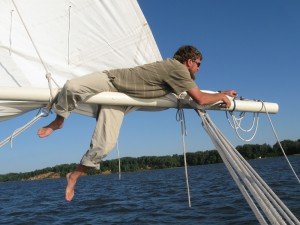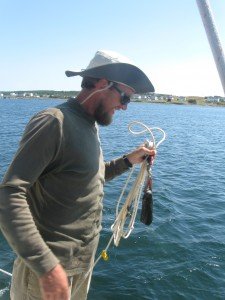
There’s a lot of talk, in online forums, on blogs, and in magazines, about what exactly constitutes ‘Good Seamanship’. For some it seems to boil down to having more stuff: good seamanship is about having three or four independent navigation systems in lightning-proof Faraday cages scattered throughout the boat; a second liferaft; AIS; personal and main EPIRBS; Radar; Satphone; Spot tracker; MOB pole; self-inflatable lifejackets with PLBs; a sailplan on file with someone onshore, and watertight tubs of spares and backups for for everything onboard that could possibly fail. They might also have, in addition to several automatic electric bilge pumps, an engine-driven pump that could empty an Olympic-size swimming pool in 45 seconds, and a Y-valve to turn the engine-cooling pump into an emergency bilge pump as well. None of these things are a bad thing, and a careful selection of gear is a necessary part of good seamanship, but not the only nor even the most important thing.

For others, it’s about the boat. “There’s two inches of solid glass in that hull that was laid up BEFORE the 70’s oil crisis!” they exult. “No way this baby’s going down!” They might add: “The rigging’s three times bigger than the manufacturer’s original specs, and our whisker pole was the boom off a shrimper. This thing is indestructible!.” Now there’s lots to be said for a monumentally over-engineered boat, and a good seaman looks for strength and build quality in the vessel he chooses, but it is again not the most important thing.
For others yet, it’s about rules. “Ten rules of good seamanship”—there’s been a few articles like that in the mags over the years. This is the one I’m most uneasy with, since during our voyages the practice of what seems good seamanship to me has involved breaking each of the usual ones sometime or other. One reason I dislike lists of hard-and-fast standards is that the sort of cruising we do involves a lot of out-of-the-box thinking, and inflexible rules stifle that to a certain degree. Take for an extreme example a person I once knew who took a SCUBA course which taught her that immediately upon surfacing, no matter what, the snorkel must be deployed. It caused her great distress and confusion when coming up after a dive I floated serenely in my BC with nothing in my mouth at all! (She also thought that unless stabbed with a fork beforehand, potatoes would absolutely not bake properly—so again, an extreme example of mindless rule following). What’s my point? Just that while rules are useful as guidelines for those gaining experience, there comes a time when one must move beyond them and assess each situation as it comes.

Let’s take one of the commonest ones for an example: “Never enter a strange harbor after dark.” Well, that is certainly good advice for someone unfamiliar with buoys and lights and what a ship looks like coming out of a narrow channel. But for someone who has experience running channels in the dark, is adept at reading the chart and can keep his bearings, it can be a complete non-event. In fact, that’s why ports and harbors have lighted navigational aids!

I first became comfortable entering strange places in the dark while crewing on the boat of an airline captain. Piloting by lights at five knots was nothing to him—he was used to steering by lights while flying exponentially faster in an airliner, and we routinely made foreign approaches in darkness. When Danielle and I took off on our own boat, though I was—and still am, I hope—far more timid and cautious than he, I had done enough nighttime entrances to be able to do so comfortably, and the more we cruise the more I’m convinced that it’s a skill that should be practiced against a time of need. There has been more than one occasion where good seamanship—a due regard to the safety of the boat and crew—required that a strange and unlit harbor be entered in pitch blackness rather than spend an uncomfortable and possibly dangerous night outside. Of course I try to avoid entering any place, strange or not, after dark, but knowing that I safely can do so at need is a source of comfort when landfall is imminent.

Some of the rules descend into plain silliness—“Never leave the cockpit without a safety line;” or “Never stay awake longer than 20 hours in a row.” Well, I’d like to never be awake longer than about 14, but there have been times when safety and prudence—good seamanship, in fact—demanded a thirty-hour trick at the helm. And while we generally tether in when things are getting rough, it would be absurd to do so ALL the time. You might as well insist on being tied in while going up the stairs in your house.

There are others which space will not allow me to discuss at length, such as never getting into wind-opposed currents or sailing AT ALL when a hurricane is somewhere in the same hemisphere, that, while certainly good rules of thumb, aren’t always practical or possible. No, good seamanship is not found in the inflexible adherece to lists of rules, nor is it measured by the suitableness of the boat or the amount of gear and stores it carries aboard; it’s an elusive, flexible mix of all three, blended with heavy doses of experience, prudence and good judgment. The good seaman is one who after taking reasonable precaution and preparation for the passage in view will be able to deal intelligently with every tribulation he is handed underway. I’m not much of a seaman at all even by my own generous definition—unforeseen trials underway usually serve only to drive home how bad a decision it was to go seafaring just there or then, and I wind up wishing I’d been seaman enough to simply stay ashore. We’ll probably never be able to quantify exactly what good seamanship is: we can only just go out to sea, do our best, learn from our mistakes, and go to sea again.